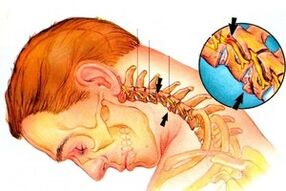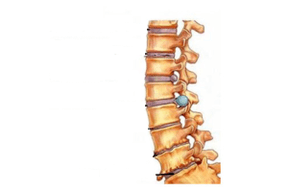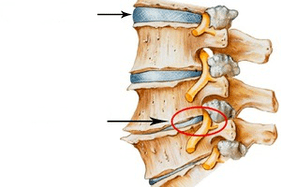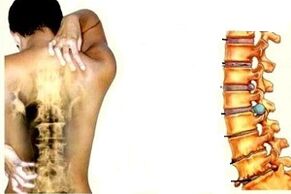
Diseases of the musculoskeletal system are one of the most common diseases on Earth.Some people have successfully avoided them, especially after 40 years, although experts acknowledge that problems with spine, muscles and joints have "younger", and very young people are complaining about pain.
This error is a way of life, which has become common to many: inactive, long -term living in one position (most often behind tools and monitors), lack of physical activity.As a result, disrupted posture, salts and other harmful substances accumulate in the body, the function of the musculoskeletal system is affected, and as a result, the internal organs can be defective.
Often, osteochondrosis is derived from the disease, where people are subject to older and younger age, and between osteochondrosis problems with lumbosacral and cervical spine.The second type of osteochondrosis, cervix, is an unpleasant disease, and in addition - progressive, without treatment, a worse lifestyle to defect.This means that it is necessary to recognize the symptoms of the disease on a timely manner and at the time contact the orthopedic or vertebrologist for treatment.
How cervical osteochondrosis develops
If a person carries an inactive lifestyle or, based on his profession, is in the same position for a long time, the risk of meeting osteochondrosis is very high.With the development of the disease, changes occur in the intervertebral disc, they are defective and changing their structure.
The intervertebral disc is located between the vertebrae, their job is to maintain the spine, to make it flexible and durable.There are seven vertebrae in the neck, with the help of heads supported and rotated, neck and so on.The cervical vertebra is very close to each other, so they are injured and shift even from small physical energy.The danger of the disease lies in the fact that the spinal cord nerve ending is affected, as the vessels that supply the brain are affected.On the other hand, the brain does not receive important ingredients, and this can lead to the development of several more serious diseases that can cause disability and even the death of the patient.
There are many causes and development of cervical osteochondrosis.Some of the most common and frequent reasons can be distinguished:

- Metabolism is affected in the body, in particular, in the cervical region, hormone imbalance;
- salt deposition;
- low physical activity, inactive lifestyle;
- long stay in one pose (on a computer, car steering, etc.);
- Incorrect nutrition;
- Overweight;
- injury and neck bruises;
- Hypothermia of the body.
Osteochondrosis also occurs in the background of chronic diseases of the musculoskeletal system, such as scoliosis or rheumatism.
In addition, osteochondrosis often leads to the body's genetic tendency.
But for any reason, osteochondrosis must be treated as soon as the first symptom appears.
Sign of cervical osteochondrosis
Osteochondrosis in this spine does not always appear significantly and unexpectedly.Often, it develops slowly, and the symptoms are increasing over time, the number increases.The more the vertebrae is damaged and the nerve root is damaged, the more significant signs.
The first symptom to pay is the pain of different strength in the cervical spine, which gives to the other part of the body - the back of the head, forehead, ear, arm, shoulder, chest, and so on.In the case of pain, consult a doctor to determine if it is true -is actually osteochondrosis, which is often the same as symptoms with other diseases.
Other signs of osteochondrosis
- Neck pain is enhanced by the load or turn of the head;
- The patient feels numbness, burning or tingling in the limbs;
- headache and dizziness, fractions, patients can complain about darkness and flies in his eyes, sound in his ear;
- With a sharp head turn, fainting is possible.
Osteochondrosis is also a feature of cervical osteochondrosis:
- Coordination violations;
- pain in the heart;
- Deterioration of vision and hearing.
Varieties of osteochondrosis
Depending on the type of nerve pinching and the nature of the disease, the doctor distinguishes some syndrome:
- spinal syndrome;
- vertebral artery syndrome;
- Cardial Syndrome.
Root syndrome is to pinch the first pair of cervical nerve endings.The pain is felt in the neck, they are given to the shoulder blade, lower back, shoulders, lower arm.
With vertebral artery syndrome, the patient suffers from pulsating pain in the back of the head or temple or the pain in the neck, the back of the head, which increases the head, during sleep, with cough, giving it to the chest, shoulders.
With cardiac syndrome, the first symptoms resemble angina pectoris, but the pain does not pass after taking nitroglycerin, lasting several hours and can be intensified during moving and deep breathing.
Symptoms of damage to a particular vertebrae
Treatment of osteochondrosis is prescribed based on which ends with damaged nerves.There are only eight of them, each on the cervical vertebra.It is possible to determine which vertebrae is attacked by symptoms that correspond to certain nerve spine.
Damage to pain that ends with nerves and features

- First and second departments: back sensitivity, pain in the parietal and occipital regions are broken down;
- Third Department: numbness from the neck in pinching, speech disorders, language sensitivity;It occurs very rarely;
- Fourth Department: pain and numbness in the collarbone and/or shoulders, violations of the respiratory system, heart disease;
- Fifth section: shoulder pain, pain on the outer surface of the shoulder, the sensitivity of the limbs;
- Sixth and seventh departments: pain in the neck, blade, lower arm, back, lower back, impaired hands, fingers;The most frequent loss;
- Eighth Department: Neck pain, back, elbows, finger numbness -small in all limbs, feet and brushes due to blood circulation disorders, lack of skin sensitivity, and giving it to the feet.
Diagnosis and treatment of cervical osteochondrosis

To establish a diagnosis of "cervical osteochondrosis", you must consult your doctor.Many symptoms of osteochondrosis are similar to other signs of diseases, so it is important not only to start the treatment of osteochondrosis, but also not to miss other pathologies.
If suspected osteochondrosis and signs of pinching nerve endings, doctors prescribe radiography, with computerized resonance tomography or magnetic data, ultrasonic additional dopplerography and duplex scanning.
Based on this study, the nature of the pain syndrome and the whole symptom, you can determine which disc is damaged, and initiates the necessary treatment, which will restore the vertebral and nerve root and will not allow the complications of osteochondrosis to develop.
This treatment is prescribed by a doctor, usually complex.First of all, it should relieve the symptoms of pain, which, with cervical osteochondrosis, sometimes practically cannot be borne and spread not only to the neck, but also to other parts of the body.
To do this, use painkillers in the tablet, but in the case of severe pain, anti -ssteroid inflammation, as well as heating and painkillers, are indicated.
Because medications and ointments only relieve pain and other symptoms of neck osteochondrosis, but do not eliminate the cause.After the painful sensation is reduced, the patient is prescribed massage, physiotherapy, and physiotherapy.Patients show diets, medications that improve blood circulation and support body function, in tablets and injections, as well as chondroprotectors that help protect and restore intervertebral disc fabrics.
In some cases, baths, paraffin applications, reflexology, hirudotherapy are prescribed as an additional treatment for patients.People's methods of treating cervical osteochondrosis often help to restore patients to a normal lifestyle, but they can only be used in combination with traditional methods and after consulting with doctors, as traditional medicine can have contraindications, and prescription use can harm the body to the body.
Complications and Prevention of Disease

Remember: Treatment for cervical osteochondrosis should be started as soon as possible.The longer you make a visit to your doctor, the more difficult to cure the disease, and in the meantime it can cause a variety of complications.Cervical spinal osteochondrosis is very dangerous because in this area there are many blood vessels and nerve plexus that feed the brain.
Any infringement can cause problems with brain circulation, neurological disorders, including migraines and hypertension, affecting the liver, respiratory system, hearing, vision.
If osteochondrosis is launched, more serious consequences are possible in the form of brain ischemia, spinal stroke or radiculopathy - a disease in which the process is formed on the affected vertebrae, partially or completely damaging the body of sensitivity and mobility.But this is not the worst thing, because in severe osteochondrosis, the spinal cord is compressed, which can cause the patient's death.
Therefore, it is very important to hear symptoms as soon as possible and turn to a specialist who will help you get back to full life.And to prevent diseases such as cervical osteochondrosis, you need to move more, do not avoid physical activity, monitor weight, eat properly and balanced, and also visit orthopedists or vertebrologists.

























